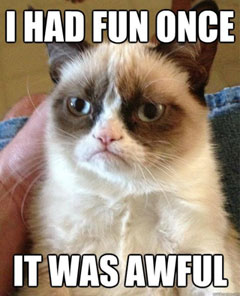Humor
Part III of the book addresses the myriad ways humor is portrayed in social media spaces.
Phreaks, Hackers, and Trolls
In "Phreaks, Hackers, and Trolls: The Politics of Transgression and Spectacle," E. Gabriela Coleman (2012) argued that the singular term "hacker ethic" (focused on rhetorics of freedom and distrust of authority) is made more complicated by a closer look at humor online, where one can "easily identify variance, ambiguity, and, at times, even serious points of contention" (p. 99). To look more closely, she traced the history of Internet hacking beyond the singular narrative of the academic strain born at MIT in late 1950s, looking at other historical movements such as phreaks who made their way from phone to Internet hacking in the late 1970s (p. 101). Coleman argued that "the marked hyperbole and spectacle among phreakers, hackers and trollers not only makes it difficult to parse out truth from lies; it has made it difficult to decipher and understand the cultural politics of their actions" (p. 101).
So what differentiates phreaks, hackers, and trolls? Coleman chronologically traces the origins of the freaking and phreaking movements in the 1950s and 1960s with the technologists who were underground "spelunkers of the phone system," who joined a far-leftist anarchist political movement in the 1970s called the Yippies and began publishing information about tapping into the phone system and fighting AT&T (p. 102–104). While the connection to the political movement was short-lived, it did give visibility to the "audacious politics of pranking, transgression, and mockery that already existed among phreaks (p. 105). It also inspired and spurred hacking into textfiles and later the creation of phreaker/hacker publications such as Phrack in the 1980s and 1990s (p. 107). The 1990s marked a time of thriving hacker underground activity, but also criminal prosecution of hackers to make examples in an attempt to deter their subversive behavior. The rise of popular Internet culture in the 2000s coincided with post-9/11 legislation that cracked down on hacking, yet as more and more people flocked to the Internet, there was a rise of trolls, or pranksters who "work to remind the 'masses' that have lapped onto the shores of the Internet that there is still a class of geeks who, as their name suggests, will cause Internet grief, hell, and misery; examples of trolling are legion" (p. 110).
Trolls differ from phreakers and hackers in that their aims differ: "lulz [plural for 'laughing out loud'] are often cited as the motivating emotional force and consequence of an act of trolling" (p. 111). This is a much different motivation than exists for phreakers and hackers, which Coleman argued is "self-directed realization of skills, goals, and talents—more often than not achieved through computing technologies" (p. 112). Coleman closed the essay by positing whether any "ethical substance" to the activities of any of the three groups can be ascertained from their spectacle, and compared them to the trickster in myth, who often would use trickery and spectacle to "do good in the world." The problem is, as Coleman noted, the troll may not always be looking for good as much as for "the lulz" (p. 115–116). Parsing out intent is key to differentiating trolls from phreakers and hackers.
The Meme
Patrick Davison (2012), in "The Language of Internet Memes," described his aim as two-fold: to provide vocabulary for the Internet meme, and to discuss anonymous authorial attribution that is a part of the Internet meme's makeup (p. 120). The origin of the term meme is in The Selfish Gene by Richard Dawkins (1979), in which Dawkins described the difference between human behavior deriving from genes versus culture. As Davison (2012) described,
[m]emes determine the behavior of an organism. They are either taught to an organism (you go to school and learn math) or learned through experience (you stick a finger in an outlet, get shocked, understand that outlets should be avoided). . . . In Dawkins' original framing, memes described any cultural idea of behavior. (p. 121)
The term Internet meme requires more description. Davison offered the following: "[a]n Internet meme is a piece of culture, typically a joke, which gains influence through online transmission" (p. 122). Internet memes are both replicable, or easily transmitted and shared, and malleable, or subject to manipulation.
Davison further theorized that an Internet meme has three components: the manifestation ("its observable, external phenomena"), the behavior ("the action taken by an individual in service of the meme"), and the ideal ("the concept or idea conveyed") (p. 123). Davison used examples of Internet memes to show these components. First, he examined the emoticon, specifically the Hamster Dance, as an early Internet meme. He then moved into currently popular Internet memes such as the image macro, a specific type with "a set of stylistic rules for adding text to images" (p. 127). These often involve adding text to images in a recognizable and easily transmittable stylistic manner, and he provided visuals of each to demonstrate their appearance and function. I have included another example in the sidebar.
Davison concluded by arguing that the non-attribution of authorship to popular Internet memes is itself a meme, "insofar as it exists and replicates within certain populations. . . . Memes can be born, replicated, transmitted, transformed, and forwarded with no concern for rights management, monetization, citation, or licensing" (p. 132). He ended the essay by leaving readers with the following question: How important might non-attribution be on a network in which attribution is so often required?
Readers will find both the history offered by Coleman and the theoretical vocabulary offered by Davison about the meme extraordinarily useful. That being said, there is much more that might be included here, and much more still that has yet to be theorized and articulated. The Internet meme is but one cultural phenomena among countless others that circulate on social media, but it does serve as a helpful example for the purposes of this collection.
